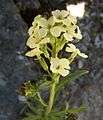Erysimum
| Erysimum | |
|---|---|
 | |
| Erysimum scoparium | |
| Scientific classification | |
| Kingdom: | Plantae |
| (unranked): | Angiosperms |
| (unranked): | Eudicots |
| (unranked): | Rosids |
| Order: | Brassicales |
| Family: | Brassicaceae |
| Tribe: | Erysimeae |
| Genus: | Erysimum L. |
| Species | |
|
Over 180, see text | |
| Synonyms | |
and others | |
Erysimum (wallflower) is a genus of flowering plants in the botanical family Brassicaceae, that includes about 180 species, both popular garden plants and many wild forms. The genus Cheiranthus is sometimes included here in whole or in part. Erysimum has recently been ascribed to a monogeneric cruciferous tribe, Erysimeae. This tribe is characterized by sessile, stellate and/or malpighiaceous trichomes, yellow to orange flowers and multiseeded siliques.
Morphology
Wallflowers are annuals, herbaceous perennials or sub-shrubs. The perennial species are short-lived and in cultivation treated as biennials. Most species have stems erect, somewhat winged, canescent with an indumentum of bifid hairs, usually 25 ± 53 cm x 2–3 mm in size, and t-shaped trichomes. The leaves are narrow and sessile. The lower leaves are linear to oblanceolate pinnatifid with backwardly directed lobes, acute, 50–80 mm x 0.5–3 mm. Stem leaves are linear, entire, all canescent with 2-fid hairs; 21–43 mm x 1.5–2 mm. Inflorescences are produced in racemes, with bright yellow to red or pink bilateral and hermaphrodite, hypogynous and ebracteate flowers. Flowering occurs during spring and summer. One species, Erysimum semperflorens, native to Morocco and Algeria, has white flowers. The floral pedicel ranges from 4 to 7 mm. Four free sepals somewhat saccate, light green, 5–7 mm x 1.5–2 mm.
Distribution
Wallflowers are native to southwest Asia, the Mediterranean, Europe, Africa (Cabo Verde), Micronesia, and North America through Costa Rica. Many wallflowers are endemic to small areas, such as:-
- E. scoparium (the Teide volcano on Tenerife)
- E. aetnense (Mount Etna)
- E. franciscanum (north Californian coast)
- E. nevadense (the Sierra Nevada of Spain)
- E. moranii (Guadalupe Island)
- E. teretifolium (endangered - inland sandhills of Santa Cruz County, California)
- Erysimum kykkoticum (Cyprus - nearly extinct)
Cultivation
Most wallflower garden cultivars (e.g. Erysimum 'Chelsea Jacket') are derived from E. cheiri (often placed in Cheiranthus), from southern Europe. They are often attacked by fungal and bacterial disease, so they are best grown as biennials and discarded after flowering. They are also susceptible to clubroot, a disease of Brassicaceae. Growth is best in dry soils with very good drainage, and they are often grown successfully in loose wall mortar, hence the vernacular name. There is a wide range of flower color in the warm spectrum, including white, yellow, orange, red, pink, maroon, purple and brown. The flowers, appearing in spring, usually have a strong fragrance. Wallflowers are often associated in spring bedding schemes with tulips and forget-me-nots.[1]
The cultivar 'Bowles's Mauve'[2] has gained the Royal Horticultural Society's Award of Garden Merit.
Ecology
Erysimum species are used as food plants by the larvae of some Lepidoptera (butterfly and moth) species including the Garden Carpet (Xanthorhoe fluctuata). In addition, some species of weevils, like Ceutorhynchus chlorophanus, live inside the fruits feeding on the developing seeds. Many species of beetles, bugs and grasshoppers eat on the leaves and stalks. Some mammalian herbivores, for example Mule Deer (Odocoileus hemionus) in North America, Argali (Ovis ammon) in Mongolia, Red Deer (Cervus elaphus) in Central Europe, or Spanish Ibex (Capra pyrenaica) in the Iberian Peninsula, feed on wallflower flowering and fruiting stalks.
Most wallflowers are pollinator-generalists, their flowers being visited by many different species of bees, bee flies, hoverflies, butterflies, beetles, and ants. However, there are some specialist species. For example, Teide wallflower is pollinated almost exclusively by Anthophora alluadii.
Selected species
|
|
Gallery
 Erysimum wittmanii inflorescence
Erysimum wittmanii inflorescence
 Erysimum helveticum
Erysimum helveticum- Erysimum allionii inflorescence
References
- ↑ RHS A-Z encyclopedia of garden plants. United Kingdom: Dorling Kindersley. 2008. p. 1136. ISBN 1405332964.
- ↑ "Erysimum 'Bowles's Mauve'". Royal Horticultural Society. Retrieved 26 July 2013.
External links
| Wikimedia Commons has media related to Erysimum. |
| Look up wallflower in Wiktionary, the free dictionary. |
- Evoflor, a web page on Erysimum floral evolution
- webpage of a UK collector of erysimums
- Herbario del Instituto Pirenaico de Ecología, CSIC (Jaca, Aragón, Spain)
- Botánica Sistemática, an open web on plants